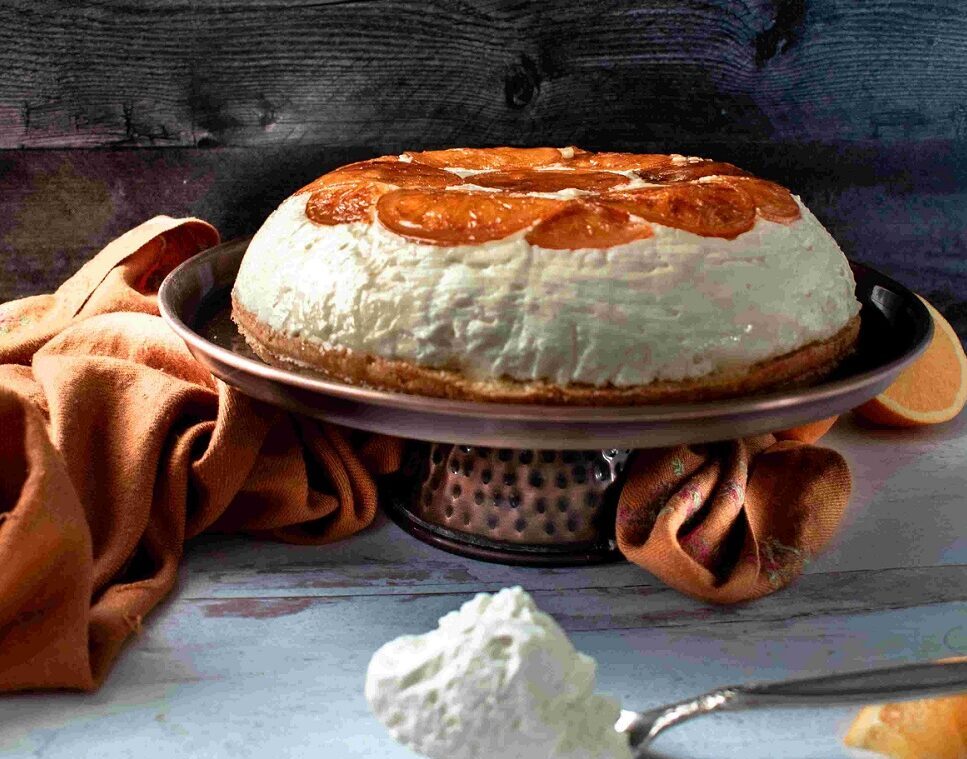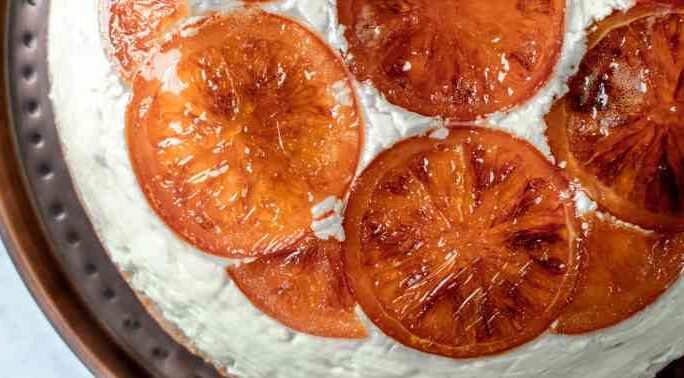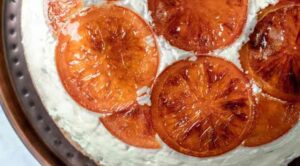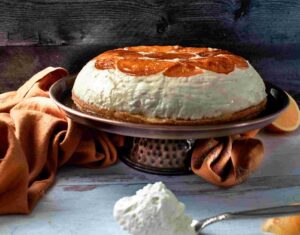Rosace a L’Orange

A classic Rosace a L’Orange, made up of layers of genoise sponge and creme legere, a mix of creme patisserie and whipped cream, on top of which sit soft candied orange slices. A French classic which isn’t as difficult as its reputation.
Jump to RecipeUn Challenge
I love a good chaa-laaange. That’s about as much French as I speak. My boyfriend, thankfully, is fluent and sometimes I use his linguistic skills to translate some obscure and not so obscure French recipes tucked away in the back of a book. This time, Mary Berry’s recipe for Rosace a L’Orange peaked my interest when appearing on one of my favorite things, Great British Baking’s Holiday Masterclass (I will always spell words the UK way if given the opportunity.) It was featured as a lighter alternative to Christmas dessert.

This recipe is based off of Mary Berry’s ingredient wise. Her instructions were also wonderfully helpful, but I decided to go looking for the origins of things, as I tend to do with food and history. That led me to the beginnings of this “stained glass” dessert. It is essentially an upside down cake of the grandest variety, the words Rosace a L’Orange meaning “rosette with orange.”
Gaston’s Rosette
When I first stumbled upon an old Youtube video of French pastry chef Gaston Lenôtre on the French programme “La Grande Cocotte” from 1977, I felt elated and as if I found the best possible recording of French technique to make this special dessert (which, in my recipe categories at A Quarrel of Feasts, I refer to as Special Sweets. This is one.)
At the same time, I located an old New York Times article from 1978 spelling out Gaston’s recipe, along with many of his other French patisserie and baking classics. The article is short, to the point, and not nearly as descriptive as the recipes seem to be today. In a way, I like that. It makes me work more to discover the magic myself. I can’t seem to locate the video now, which is for the best. It taught me well.
What I didn’t know what that the video of the French television show in the late 70’s and Gaston Lenôtre himself had created the Rosace a L’Orange and had first presented it on this very show. The recipe was originally published in his book “La Pâtisserie/ Grands Classiques et Créations.”
Stained Glass Baking
I found myself studying at the very source of this creamy, orange majesty, coming in via wobbly television waves and a lost article archive. I studied this wellspring of ingredients and technique. I watched the video over and over again, asking my boyfriend to translate and then ignoring the translation as I just watched his hands dance this recipe into creation. For safety, I kept returning to Mary Berry as well. Her instruction was like the comforting English mum trying to make sense of a hard-to-understand, antiquated French father as he told us the story of his homeland.
I originally made the Rosace a L’Orange on a wintry early March day, just weeks before the pandemic hit our eyes and routines. I was focused and took things one step at a time.
Was it perfect? No.
The Genoise sponge had to be baked twice, since my first one didn’t rise.
My oranges got too candied and sat around too long, so therefore hardened quite a bit. The best unintended result of that was that they looked utterly magnificent in photos–burnt orange and shiny like the stained glass they represent.
Moving Parts
The elements are clear: Make a genoise cake, cut it in half, candy some oranges in sugar and water for two hours, make a creme legere, which is a marriage of a creme patisserie and whipped cream with some of the candied orange sliced into it, and make an orange syrup.
In a large, deep, glass bowl lined with plastic wrap, the candied oranges, after being brushed with orange syrup, are arranged carefully to fit into a stained glass pattern. This is the most tedious part of the process. Half of the creme legere is added into the bowl onto the orange slices, followed by the first half slice of genoise brushed with orange syrup, which is cut to fit the middle section of the bowl, and topped with the other half of the creme legere, this time including diced bits of candied orange, and the other half of the genoise, also brushed with syrup. Once intact, the whole thing is tightly wrapped in plastic wrap and very carefully refrigerated. After a time, the moment of truth–you turn out the whole thing into a perfect Rosace a L’Orange.
Sound easy? It is worth the journey. Come with me and learn. Gaston, Mary, me, and now you are all part of the great heritage of this beautiful dessert. I am finally posting this for Bastille Day 2020. It is a hot summer, the pandemic is still orchestrating a new life for all of us, but baking is still on. Whether a light holiday dessert or a creamy summer treat, this French secret is out.
Here’s what I learned during my journey into Rosace a L’Orange…
Notes, Tricks, & Lessons Learned
- When you are candying the oranges for two hours at a very low heat, it must be a very low heat. My lowest stove temperature is not adjustable and was a little high, which is why my oranges over candied. The look was beautiful, but they were not as soft to eat as they should have been. So, keep your heat super low if possible and keep an eye on it. Stir, stir, stir!
- Genoise is tricky as most know. Make sure to keep the air in your batter so it rises enough to slice in half. Very delicate folding is the key, along with allowing your eggs to stiffen up enough.
- Keep an eye on your heat when making creme patisserie and allow it to fully cool before folding in the whipped cream. Also, cut up your orange pieces nice and small so they evenly distribute.
- The most important part of the process is arranging the orange slices into the bowl. A big glass bowl that is rounded at the bottom is ideal, and two levels of plastic wrap (use the good stuff.) Spray the bowl liberally with cooking/baking spray and take your time laying the layers into the bowl. Try to press out any folds or extra gathering of wrap, but make sure it is securely pressed to the bottom and sides of the bowl. Be equally as careful when lying the orange slices down.
- Be patient with yourself! This is not difficult if you move slowly, don’t rush, and organize things correctly. The recipe below has plenty of details along the way.
Rosace a L’Orange
Equipment
- Deep, rounded glass bowl 9-10 inch diameter
- Springform pan or cake tin, 9 inches
Ingredients
Candied Oranges
- 3 oranges
- 4 cups water
- 2½ cups granulated sugar
Orange Syrup
- ¼ cup Grand Mariner
- ⅔ cup reserved liquid from candied oranges
Genoise Sponge
- 4 tbsp unsalted butter
- 4 eggs
- ½ cup extra fine granulated sugar (or process until fine)
- ⅔ cup plus 1 tsp all purpose flour, sifted
Creme Legere
- 1 cup whole milk
- ½ tsp vanilla extract
- 3 egg yolks
- ⅓ cup granulated sugar
- 2 tbsp cornstarch
- 1 tbsp unsalted butter
- 3 cups heavy whipping cream
Instructions
For the Candied Oranges
- By hand or with the slicer attachment of a food processor (which I used for uniformity), slice the oranges.
- In a wide pan over medium high heat, add in the sugar and water. Stir until the sugar dissolves and the water runs clear.
- Once it boils, add the orange slices and bring back to boil. Reduce the heat and simmer for 1.5-2 hours over a VERY LOW heat.
- Remove from heat and allow to cool. Drain orange slices over wire rack and set aside the liquid.
For the Orange Syrup
- Combine the candying liquid with the Grand Marnier.
- Add the juice of one orange and set aside.
- Prep the bowl with cooking spray and two layers of plastic wrap. See notes above.
- Once the oranges have cooled, see notes above and arrange the orange slices into the plastic wrapped bowl. Start with one whole slice in the middle, then whole slices around the center piece, keeping the edges as close together as possible, but not overlapping. Cut quarter slices and add in between the rounded edges to fill in the gaps. Set aside.
- Slice the remaining orange slices into small, diced pieces. You want to have about 1/2 cup to use for the creme legere, but the amount is up to you.
For the Genoise
- Preheat the oven to 355 degrees. Grease cake pan with cooking spray and parchment paper on the bottom.
- Over a low heat, melt the butter in a pan and set aside to cool. In a mixer, whisk eggs and sugar at high speed until light and creamy and mixture has thickened to the consistency of early stage meringue (thick and leaving an impression).
- Carefully fold half the flour into the batter. Pour half the melted butter around the outer edges of the bowl and fold in. Fold in the other half of the flour and then the butter. Fold equally as gingerly, making sure not to knock the air out of the batter.
- Pour the batter into the baking tin. Bake for 25–30 minutes, making sure the cake toothpick tester comes out clean, the cake has a bounce to it, and it has fully risen. Allow to cool for 5-10 minutes and then cool completely on a wire rack.
For the Creme Legere
- Add the milk into a saucepan over high heat and bring just under a boil. Cover and set aside.
- In a mixer, whisk sugar and egg yolks until a silky, thickened texture forms in a vibrant yellow color.
- Very slowly add the warm milk (after skimming any skin off the top) into the egg and sugar mixture, while continually whisking.
- Return the mixture to the saucepan over a medium low heat, while continuously whisking. Keep stirring until thickened. Add in the vanilla extract until just combined.
- Cover with plastic wrap pressed right into the cream to avoid a skin forming. Set aside or refrigerate to cool completely.
- In a cold metal bowl, whip the heavy cream on medium high speed until soft peaks form. No need to add sugar, since you will be mixing in with the creme patisserie.
- Once the creme patisserie is cold, fold the whipped cream (which you also keep in a refrigerator to cool) into the creme patisserie.
To Assemble
- Once your oranges are set in your bowl, your creme legere is combined, and your cake is completely cool, cake the genoise cake in half.
- Into the bowl on the display oranges, add half of the creme legere mixture and smooth to flat. On top, you will place the first piece of genoise cake that has been trimmed down to fit halfway up the side of your bowl. If a little too tight, you can make sure to tuck it in, but it must not fold or allow air to get in between the layers.
- Brush the cake with the reserved Grand Mariner syrup.
- Into the other half of the creme legere, add in the diced orange pieces and mix to distribute. Spoon the remaining cream into the bowl and smooth to flatten.
- Take the remaining half of genoise cake and place onto the cream. It should fit as is snug near or at the bottom of the bowl. Brush the cake with the syrup and place a plate that fits into the edges of the bowl into the bottom of the layers. Make sure it is nice and tight!
- Refrigerate the Rosace a L'Orange for 4 hours minimum. Overnight is best — you don't want to risk the creme not setting.
- When ready to turn out, carefully turn the bowl over and leave for 10-15 minutes to loosen naturally. You can even run the bowl under hot water for 30 seconds to loosen it up.
- When ready, VERY carefully remove the bowl and slowly take away the layers of plastic. The Rosace a L'Orange is best when enjoyed fresh that day or the next day at most. It is difficult to keep it in the refrigerator, even when covered, since it absorbs any smells and flavors that surround it. Don't wait, enjoy this French beauty you took the time to create!



